|
Margaret
River, Western Australia
Part
3:
Moss Wood
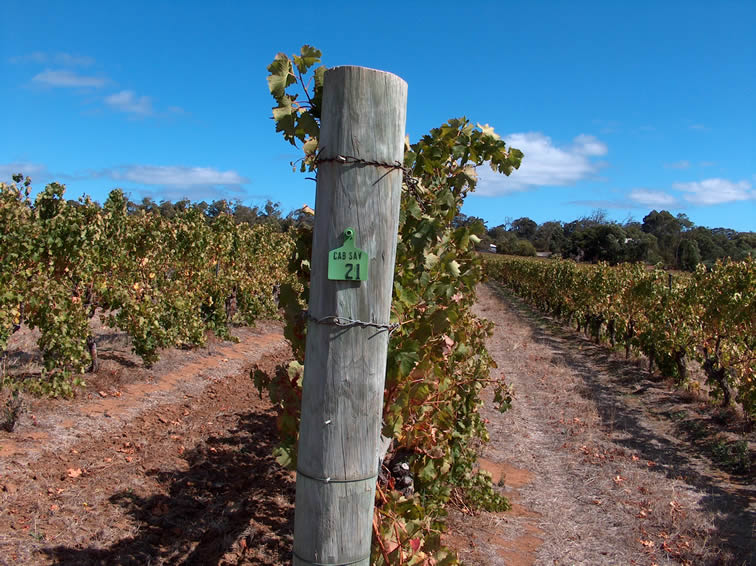
When I arrived at Moss Wood, the last reds of 2007 were being
pressed. 'Everything looks positive', reported winemaker Josh
Bahen, who together with vineyard manager Steve Clarke hosted my
visit.
Moss Wood is one of the most celebrated of Margaret River
wineries. Back in the late 1960s, when Margaret River had first
been identified as a promising potential wine region by John
Gladstones, Bill and Sandra Pannell spent six months searching the
area for ideal land for a vineyard. Eventually he identified a
site at Wilyabrup, and in 1969, they established Moss Wood.
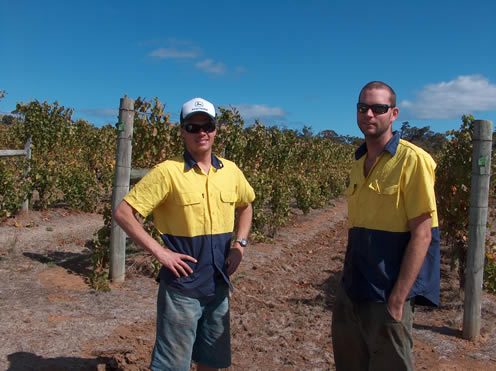
This was one of the four Margaret River pioneers, along with
Cape Mentelle, Vasse Felix and Cullens. Pinot Noir, Semillon and
Chardonnay followed in the years to come. Roseworthy graduate
Keith Mugford was hired as winemaker in 1978; eight years later he
and his wife Clare purchased Moss Wood from the Pannells.
Around 200 tons of fruit are harvested each year, which
translates into 15 000 cases. All the fruit is from their own
vineyards, with the exception of two parcels they buy in annually.
Total vineyard area is just under 20 hectares.
No irrigation is used, and the vines are all cane pruned. Many
of the vineyard plots make use of the Scott-Henry trellising
system, with dual upward and downward facing canopies, creating a
wall of vines sort of effect (see the picture). This is an
adaptation to the high vigour of some of the sites, and the dual
canopies help to get the vine into balance. More light gets to the
fruit zone and there is less disease. It is labour intensive,
though, with three or four passes through the vineyard needed to
get the lower canopy shoots down right.
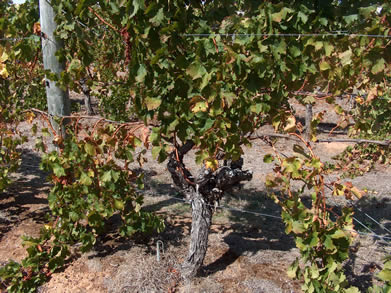
The dual canopy system, with
each vine being pruned to four
canes, two on each side
But a good portion of the vineyard is on a simple T trellis,
due to its age. Older vines are usually a bit less vigorous, which
is probably one of the reasons why old vine fruit is so highly
regarded. The Old Block Cabernet vineyard here was the second
vineyard planted in Margaret River, and so is almost 30 years old.
It produces the best fruit.
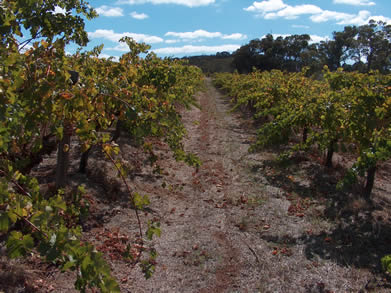
The old Cabernet vineyard
Quite a bit of leaf plucking is done here. This is the
selective removal of leaves that are in the fruiting zone to allow
direct sunlight to hit the fruit. This can be a good or bad thing:
sunlight helps to ripen the berries properly and causes the green
tasting methoxypyrazines to be metabolized. But if it is too
intense, it can burn the berry skins and affect the aromatic
compounds in the grape.
So they've trialled the procedure. For Chardonnay, they like
the combination of half leaf-plucked fruit with half
non-leaf-plucked fruit. For Cabernet, three options were tried: a
control with no leaf plucking, then half leaf plucked and fully
leaf plucked. We got to taste the results, so more on this later.
A big viticultural headache in Margaret River is the Cape
garden weevil. This can strip the young vine growth out
completely, and there's very little alternative but to control it
chemically with chlorophos. They eat cape weed in the winter and
then when the soil temperatures increase they emerge and eat the
vine shoots. Chickens or guinea fowl have been tried, but the
chickens tend to get eaten by foxes and the guinea fowl get run
over. Wind damage can also be a problem here, although Moss Wood's
vineyards are quite well protected. As Moss Wood is just 1 km from
the coast, it can be five or six degrees cooler on really hot
days.
We took a quick trip to the neighbouring Ribbonvale vineyard,
which Moss Wood purchased in 2000. It's a great terroir, with 30%
gravel content in the soil.
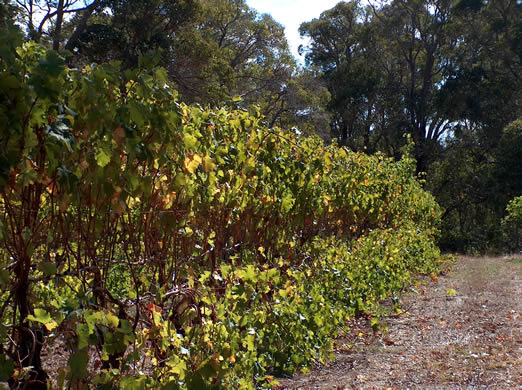
Ribbonvale: this is Sauvignon
Blanc
In the winery, work is as careful and non-interventionist as
possible. There is no sulfur dioxide used at pressing as it can
extract phenolics from the skins, which you want to avoid for
white wines. The must is not pumped until the wine has been
pressed (the risk of extracting harsh phenolics from seeds present
would be too high), so gravity or elevators are used.
Then we tasted the wines. The star of the show is the Cabernet
Sauvignon. 'All the Cabs need time', says Josh. 'We did a 1975 –2003
vertical a while ago and some people thought the 1975 was the best
wine'.
Moss Wood Semillon Sauvignon Blanc 2006
The Sauvignon was picked in three passes over five days to
move through the fruit spectrum for this variety, from very grassy
to tropical. The Semillon was picked at 12.5-13 Baume. This has a
fresh, bright fruity nose that leads to a crisp, full palate with
good weight. Crisp, fresh and balanced. 89/100
Moss Wood Semillon 2006
No oak used here. 2% solids are added to the ferment. Fresh,
full and lemony. Quite precise, with a nice stylish character and
a light juicy finish. 89/100
Moss Wood Pemberton Chardonnay 2005
This is the last vintage made of this wine: controlling
quality out there was too difficult. Herbal edge to the nose,
which continues to the palate. Fresh, but very herby, and may end
up with tinned peas character. 84/100
Moss Wood Chardonnay 2006
Apparently the lees don't start breaking down until three
months, and even after a year they haven't broken down all that
much, so there isn't a lot to be gained by lees stirring save
for a bit of oxygen. So they leave this on the lees unstirred for
10–11 months. It has a stylish rich, toasty, nutty nose. The
palate is broad and rich with nice restraint. Good balance here
with some complexity and a spicy edge. 91/100
Moss Wood Pinot Noir 2004
Pinot can be pretty variable in Margaret River. This is a good
one, though. Deep coloured, it has a nice sweet nose that shows
bright, sweet dark fruits with a bit of cherry. The palate is
quite fresh with nice structure and good fruit. It's big for a
Pinot but it's still a nice wine. 90/100
Moss Wood Amy's Cabernet
Sauvignon 2005
From a vineyard parcel bought in, this is 86% Cabernet, 10%
Malbec, 4% Petit Verdot and Merlot. Deep coloured, it has a
stylish blackcurranty nose with a bit of creamy richness. The
palate shows bright, rounded, concentrated fruit with a nice spicy
edge. A stylish Cabernet with good weight. 90/100
Moss Wood Ribbonvale Cabernet
Merlot 2004
Pinot and Merlot are the two varieties that suffer most from
high crop load. This wine has a rich, ripe blackcurrant and berry
fruit nose with stylish, spicy, full fruit. Chunky and richly
fruited, with good structure – a really nice wine. 92/100
Moss Wood Cabernet Sauvignon
2003
This is normally 95% Cabernet with some Petit Verdot, Merlot
and Cabernet Franc making up the blend. Smooth, dark, rich elegant
nose of cassis with a touch of chocolate. Concentrated, pure fruit
on the palate, which is elegantly rich, with the primary fruit
complemented by spiciness and savoury structure. Serious. 93/100
Moss Wood Cabernet Sauvignon
2004
Elegant, smooth, rich sweet spicy fruit on the nose, showing
very pure cassis aromas. The palate is concentrated, rich and full
with lovely sweetness to the fruit and dense, tight structure. A
massive wine; very sophisticated. 93/100
Moss Wood Cabernet Sauvignon
2005 (cask sample of final blend)
Rich, dark, intense and mouthfilling, with great density and
intensity of tannic structure. A remarkable wine. 93–95/100
Moss Wood Cabernet Sauvignon
2006 (cask sample of final blend)
Lighter, showing some oak. Quite stylish in this lighter
style. Picked five weeks later than the 2007. Shows nice focused
fruit and is quite elegant. 89–91
Moss Wood Cabernet Sauvignon
2007 barrel samples: this is where the results of the leaf
pluck experiment can be seen
100% exposed fruit – very ripe,
sweet, intense and big. Inky dark. An intense, sweet style.
50% exposed. Bit more structured
and there's more freshness. Still very dark, intense and focused.
Control – more of a herby
character. Focused, bright and with fresher, herbier fruit.
Wines tasted 04/07
Find
these wines with wine-searcher.com
Back
to top
|

